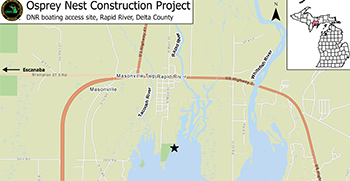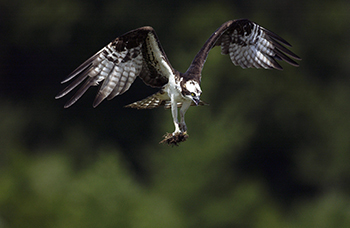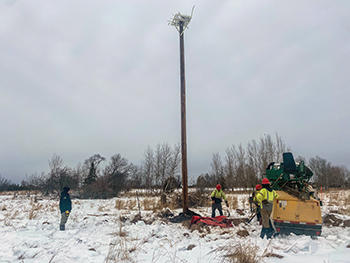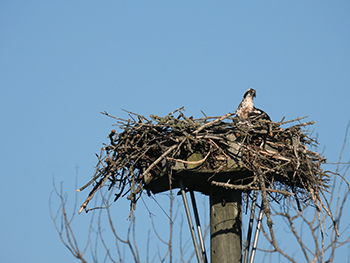Cooperative project in Delta County provides new nesting platform for ospreys
By JOHN PEPIN
DNR deputy public information officer
Michigan Department of Natural Resources
On a frozen and snow-covered marsh in Delta County, electrical workers move a specialized pole into place, firmly in the ground, allowing it to stand.
At the top of the 30-foot pole, a square, metal platform has been fashioned with matching attached arms at the corners that extend nearly 3 feet off the side.
To finish their installation project, the workers decorate the platform with dead sticks in hopes of attracting ospreys in the weeks to come. Ospreys were once one of Michigan’s threatened birds of prey.

This nesting site in Masonville Township is situated near a Michigan Department of Natural Resources boating access site in an area where the Rapid, Whitefish and Tacoosh rivers empty into Lake Michigan at Little Bay de Noc.
The location offers great hunting habitat for ospreys, which are the only hawk species in North America that feeds almost exclusively on live fish.
These remarkable birds, which capture fish by plunging into the water feetfirst, are often recognized by the elbow bend in their wings, which gives ospreys an M-shaped appearance in flight.
Additional identification cues for these birds nicknamed “fish hawk,” “river hawk” or “sea hawk” include dark patches under the wings and a brown stripe extending across the bird’s face. The wingspan of ospreys can measure almost 6 feet.
The recent osprey nest platform installation project, which was completed by wildlife technicians from the DNR and U.S. Department of Agriculture and linemen from the Alger Delta Cooperative Electric Association, replaced a worn and heavily used nesting platform on land owned by the Smith & Sons Lumber Co. of Rapid River.
Nest site fidelity
Ospreys have been nesting near the mouth of the three rivers in southern Delta County for more than three decades.
The Alger Delta Cooperative Electric Association first erected an osprey nesting platform there 30 years ago. At that time, ospreys had been nesting atop an old smokestack set to be torn down due to decay and safety concerns.
|

The smokestack was part of an old sawmill that once stood just southeast of the Smith & Sons Lumber Co.
From cliff ledges, trees, cactus and various human constructs, including cellphone towers and duck blinds, ospreys select their nest sites.
Advantages
“The new nest put up on March 1 was put up in a slightly different location to avoid nest disturbance from vehicles and equipment,” said Colter Lubben, a DNR wildlife technician at Escanaba. “The new location is within 300 yards from where the old nest was located and still offers great viewing from both the access road, as well as the boat launch parking lot.”
From online streaming to in-person encounters, osprey wildlife viewing is very popular, especially in association with nesting platforms.
The new location for the nesting platform in Rapid River offers additional benefits.
“This nest is in prime habitat for nesting ospreys,” Lubben said. “The nest is in a large opening away from any large buildings or trees to decrease the likelihood of nest predation by other birds.”
The male osprey typically selects the nesting site. He collects dead sticks for the nest or breaks dead limbs off trees. The female does the nest building. Nesting pairs usually produce two to three chicks.
“Alger Delta’s mission statement is: ‘Working together we provide safe, reliable, efficient energy,’” said Alger Delta office manager Shannon Priebe. “By assisting the DNR with the osprey nest, we are providing a safe place for them to nest away from our powerlines and thus helping maintain our (service) reliability for communities.”
Alger Delta linemen Jon Conger and Justin Gieszer and apprentice lineman Riley Corrigan put up the new platform.
|

Lubben, DNR wildlife biologist Joe Sage and USDA wildlife technician Kyle McGillviray built the new platform based on plans available from the International Osprey Foundation. The arm extension from the platform provides a perch for the birds.
The cooperative project is one of many across the state, nation and elsewhere to provide suitable nesting locations for ospreys. In some places, human-made nesting platforms provide nearly all osprey nesting sites. Ospreys are found on every continent except Antarctica.
“As more natural tree snags are lost to severe weather events, constructing these platforms has become more important than ever,” according to the International Osprey Foundation website.
Trouble and recovery on the home front
In decades past, ospreys were among the many bird species that were adversely affected by widespread use of now-banned pesticides. Birds of prey were especially vulnerable to these impacts and suffered large population declines.
“In the 1960s and 1970s, scientists found the pesticide DDT was biomagnifying, becoming concentrated in ospreys and other fish-eating birds and causing females to lay eggs so fragile that they cracked under the parents' weight,” the U.S. Geological Survey said in a 2016 report on an osprey study done on Chesapeake Bay. “The bay's osprey population fell to fewer than 1,500 pairs before DDT was banned in the U.S. in 1972. In 1979 Congress also banned PCBs, which can cause reproductive failure in animals. PBDEs, which were introduced as replacements for PCBs, are being phased out because of concerns about potential toxicity.”
Since these pesticides were banned, ospreys, bald eagles, peregrine falcons and many other species have exhibited dramatic recoveries.
|

A threatened species across the country, ospreys had recovered sufficiently to be removed from threatened species list in Michigan in 2009.
The International Osprey Foundation was founded on Sanibel Island, Florida in 1981 on the founding principle of the protection and preservation of ospreys worldwide.
“To that end, TIOF strives to educate the world community and offer research grants on raptor-related projects internationally. TIOF also recruits and coordinates teams of volunteers who build and maintain osprey nesting platforms and monitor osprey nests locally during breeding season,” according to the foundation’s website. “The information gathered provides research data to Osprey Watch, a central database for osprey research.”
Twenty-three countries from five continents are represented in the membership of the foundation.
The DNR is grateful to its partners in the Delta County nesting platform project in Rapid River that will continue to help ospreys and provide enjoyment to those who love to watch them.
Find out more about ospreys and their nesting habits.
|
Check out previous Showcasing the DNR stories in our archive at Michigan.gov/DNRStories. To subscribe to upcoming Showcasing articles, sign up for free email delivery at Michigan.gov/DNREmail.
Note to editors: Contact: John Pepin, Showcasing the DNR series editor, 906-226-1352. Accompanying photos and a text-only version of this story are available below for download. Caption information follows. Credit Michigan Department of Natural Resources, unless otherwise noted.
Text-only version of this story.
Crew: Workers from the Michigan Department of Natural Resources and the Alger Delta Cooperative Electric Association near the work site at the mouth of the Rapid River in Delta County. From left, Michigan Department of Natural Resources wildlife biologist Joe Sage, wildlife technician Colter Lubben and Alger Delta Cooperative Electric Association linemen Jon Conger and Justin Gieszer and apprentice lineman Riley Corrigan.
Map: A map shows the location of the new osprey nesting platform in Delta County.
Nest: An osprey is shown sitting in its nest on the old nesting platform near the mouth of the Rapid River in Delta County. (Photo courtesy of Carol Schiltz)
Osprey: Ospreys are a widespread bird species, found across the world. During the 1960s and 1970s, ospreys were one of several species affected negatively by now-banned pesticides and other chemicals.
Partners: Vehicles from the Michigan Department of Natural Resources and the Alger Delta Cooperative Electric Association are shown as a piece of heavy machinery is getting ready to be removed from a carrier.
Platform: A closer view of the osprey nesting platform before installation.
Site: A work crew gets ready to erect a new osprey nesting platform in a marshy area in southern Delta County.
Work: A work site is shown in Delta County after a new osprey nesting platform has been erected.
|